A spread-deficient cytomegalovirus for assessment of first-target cells in vaccination
- PMID: 20463067
- PMCID: PMC2897632
- DOI: 10.1128/JVI.02696-09
A spread-deficient cytomegalovirus for assessment of first-target cells in vaccination
Abstract
Human cytomegalovirus (HCMV) is a human pathogen that causes severe disease primarily in the immunocompromised or immunologically immature individual. To date, no vaccine is available. We describe use of a spread-deficient murine CMV (MCMV) as a novel approach for betaherpesvirus vaccination. To generate a spread-deficient MCMV, the conserved, essential gene M94 was deleted. Immunization with MCMV-DeltaM94 is apathogenic and protective against wild-type challenge even in highly susceptible IFNalphabetaR(-/-) mice. MCMV-DeltaM94 was able to induce a robust CD4(+) and CD8(+) T-cell response as well as a neutralizing antibody response comparable to that induced by wild-type infection. Endothelial cells were identified as activators of CD8(+) T cells in vivo. Thus, the vaccination with a spread-deficient betaherpesvirus is a safe and protective strategy and allows the linkage between cell tropism and immunogenicity. Furthermore, genomes of MCMV-DeltaM94 were present in lungs 12 months after infection, revealing first-target cells as sites of genome maintenance.
Figures
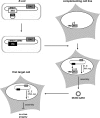
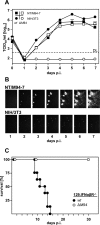
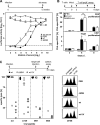

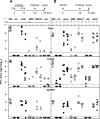
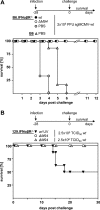
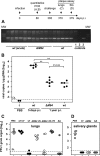
Similar articles
-
Targeted deletion of regions rich in immune-evasive genes from the cytomegalovirus genome as a novel vaccine strategy.J Virol. 2007 Dec;81(24):13825-34. doi: 10.1128/JVI.01911-07. Epub 2007 Oct 3. J Virol. 2007. PMID: 17913824 Free PMC article.
-
A Live Olfactory Mouse Cytomegalovirus Vaccine, Attenuated for Systemic Spread, Protects against Superinfection.J Virol. 2021 Oct 13;95(21):e0126421. doi: 10.1128/JVI.01264-21. Epub 2021 Aug 25. J Virol. 2021. PMID: 34431701 Free PMC article.
-
Mucosal and parenteral vaccination against acute and latent murine cytomegalovirus (MCMV) infection by using an attenuated MCMV mutant.J Virol. 1998 Jan;72(1):442-51. doi: 10.1128/JVI.72.1.442-451.1998. J Virol. 1998. PMID: 9420244 Free PMC article.
-
Dominant Antiviral CD8+ T Cell Responses Empower Prophylactic Antibody-Eliciting Vaccines Against Cytomegalovirus.Front Immunol. 2022 Jan 27;13:680559. doi: 10.3389/fimmu.2022.680559. eCollection 2022. Front Immunol. 2022. PMID: 35154089 Free PMC article.
-
Systemic priming-boosting immunization with a trivalent plasmid DNA and inactivated murine cytomegalovirus (MCMV) vaccine provides long-term protection against viral replication following systemic or mucosal MCMV challenge.J Virol. 2005 Jan;79(1):159-75. doi: 10.1128/JVI.79.1.159-175.2005. J Virol. 2005. PMID: 15596812 Free PMC article.
Cited by
-
A cytomegalovirus-based vaccine expressing a single tumor-specific CD8+ T-cell epitope delays tumor growth in a murine model of prostate cancer.J Immunother. 2012 Jun;35(5):390-9. doi: 10.1097/CJI.0b013e3182585d50. J Immunother. 2012. PMID: 22576344 Free PMC article.
-
M94 is essential for the secondary envelopment of murine cytomegalovirus.J Virol. 2011 Sep;85(18):9254-67. doi: 10.1128/JVI.00443-11. Epub 2011 Jun 29. J Virol. 2011. PMID: 21715482 Free PMC article.
-
Late gene expression-deficient cytomegalovirus vectors elicit conventional T cells that do not protect against SIV.JCI Insight. 2023 Mar 22;8(6):e164692. doi: 10.1172/jci.insight.164692. JCI Insight. 2023. PMID: 36749635 Free PMC article.
-
CD8+ T cell programming by cytomegalovirus vectors: applications in prophylactic and therapeutic vaccination.Curr Opin Immunol. 2017 Aug;47:52-56. doi: 10.1016/j.coi.2017.06.010. Epub 2017 Jul 19. Curr Opin Immunol. 2017. PMID: 28734175 Free PMC article. Review.
-
MCMV-based vaccine vectors expressing full-length viral proteins provide long-term humoral immune protection upon a single-shot vaccination.Cell Mol Immunol. 2022 Feb;19(2):234-244. doi: 10.1038/s41423-021-00814-5. Epub 2022 Jan 7. Cell Mol Immunol. 2022. PMID: 34992275 Free PMC article.
References
-
- Adler, S. P., S. E. Starr, S. A. Plotkin, S. H. Hempfling, J. Buis, M. L. Manning, and A. M. Best. 1995. Immunity induced by primary human cytomegalovirus infection protects against secondary infection among women of childbearing age. J. Infect. Dis. 171:26-32. - PubMed
-
- Andrews, D. M., C. E. Andoniou, F. Granucci, P. Ricciardi-Castagnoli, and M. A. Degli-Esposti. 2001. Infection of dendritic cells by murine cytomegalovirus induces functional paralysis. Nat. Immunol. 2:1077-1084. - PubMed
-
- Bale, J. F., Jr., S. J. Petheram, I. E. Souza, and J. R. Murph. 1996. Cytomegalovirus reinfection in young children. J. Pediatr. 128:347-352. - PubMed
Publication types
MeSH terms
Substances
LinkOut - more resources
Full Text Sources
Other Literature Sources
Research Materials

